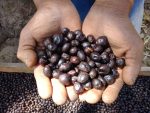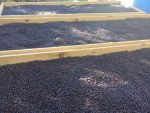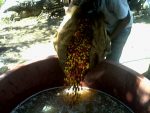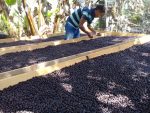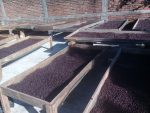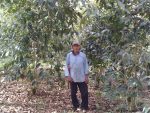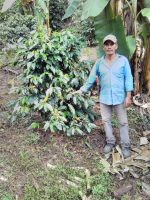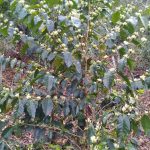87.43
a)History of the farm: The producer has 45 years as owner of the coffee area, being an inheritance of his parents, with 10 hectares cultivated and with typica and Bourbon varieties.
b). Type of crop
It is under the shadow of a mountain; with species of endemic trees of the coffee region such as: trees of the genus Inga (cajinicuiles); nanchillo, capulín (Prunus Serotina), aguacatillo (Zuelania guidonia), oaks, among others.
c). Good farming practices
Weed control is carried out twice a year; the regulation of shade and sanitary pruning is carried out after harvest, eliminating branches of the coffee tree damaged by mishandling or by pests or diseases; In addition, deep pruning or plant wasting is done, generating new vegetative material, in the months of March-April the shadow regulation is carried out.
The coffee borer bettle is controlled by placing 16 traps / ha., As an attractant, the two types of alcohols are mixed, such as ethanol and ethyl; and for the control of rust, copper-based products are applied in preventive order and in lower use the Alto 100, this was applied in September 2018, so there is no residuality.
The employed labor force is brought from the Center region using 40 day laborers every time weed control is done, doing it twice a year.
The plot is circulated.
d) Good Process Practices
Natural coffee
The cherry coffee cut is selective by reviewing the cut twice, transporting it from the farm to the community in mule beasts.
Drying in ecological beds, avoiding the contact of animals or other contamination.
In the drying stage it is carried out with constant movement, 4 times a day, avoiding transit over the grain so as not to damage it.
Coffee rises when it reaches 11.5 to 12% humidity
Storage: packed in plastic bags and jute sacks, on pallets; in a place next to the house room.
During the whole stage of the cherry cut, 8 laborers perform it per day, taking a period of 6 weeks.
| Rank | 21 |
|---|---|
| Farm Name | Las Crucesitas |
| Farmer/Rep. | Apolinar Hernández Arellano |
| Altitude | 1500 meters |
| Country | Mexico |
| Year | 2019 |
| Size (30kg boxes) | 25 |
| City | El Edén, Atoyac de Álvarez |
| Region | Guerrero |
| Program | Mexico 2019 |
| Aroma/Flavor | lychee, graham cracker, cinnamon, pear, plum, nectarine, milk chocolate, mature fruit, |
| Acidity | tartaric, mellow, juicy, |
| Other | juicy, creamy, tea like finish, smooth, |
| Variety | Bourbón |
| Coffee Growing Area | 10 hectars |
| Farm Size | 10 hectars |
| Auction Lot Size (lbs.) | 1653.45 |
| Auction Lot Size (kg) | 750 |
| Business Phone Number | Telephone:+52 0 12001230007 | WhatsApp: +521 7421023553 |
| Business Address | [email protected] |



